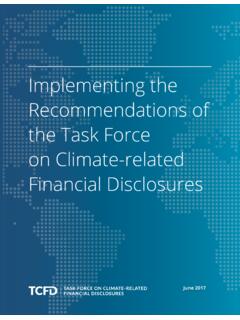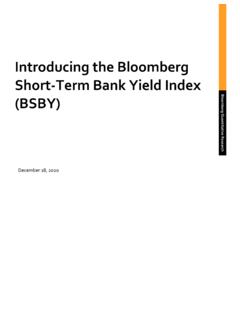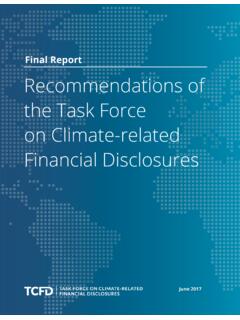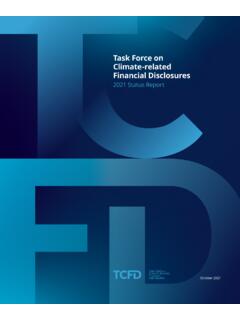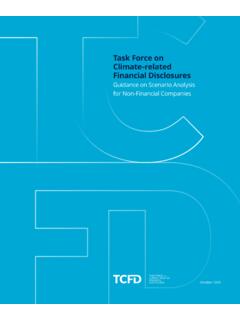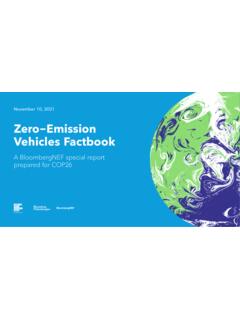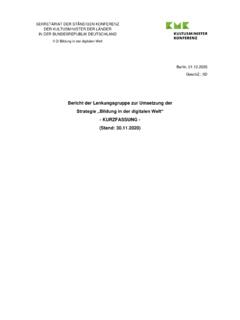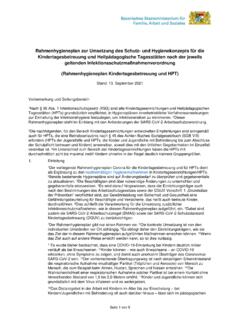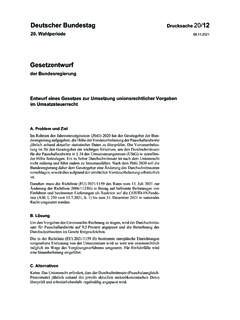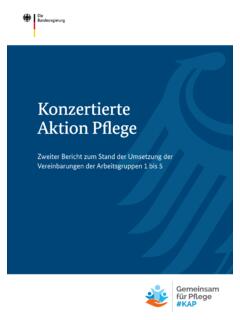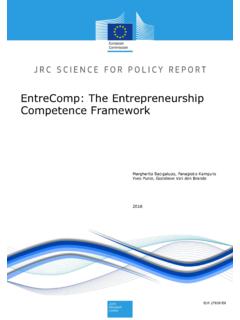Transcription of Implementing the Recommendations of the Task Force on ...
1 Task Force on Climate-related Financial Disclosures Implementing the Recommendations of the Task Force on Climate-related Financial DisclosuresOctober 2021 This document updates and supersedes the 2017 Annex " Implementing the Recommendations of the Task Force on Climate-related Financial Disclosures" Implementing the Recommendations of the Task Force on Climate-related Financial Disclosures i Contents A. 3 1. Background .. 3 2. Structure of Recommendations .. 6 3. Application of Recommendations .. 7 4. Assessing Financial Impacts of Climate-Related Risks and Opportunities .. 9 5. Summary of Additional Supporting Materials .. 12 B. Recommendations .
2 14 C. Guidance for All Sectors .. 17 1. Governance .. 17 2. Strategy .. 18 3. Risk Management .. 20 4. Metrics and Targets .. 21 D. Supplemental Guidance for the Financial Sector .. 24 1. Banks .. 25 2. Insurance Companies .. 31 3. Asset Owners .. 37 4. Asset Managers .. 44 5. Carbon Footprinting and Exposure Metrics .. 50 E. Supplemental Guidance for Non-Financial Groups .. 56 1. Energy Group .. 63 2. Transportation Group .. 65 3. Materials and Buildings Group .. 66 4. Agriculture, Food, and Forest Products Group .. 67 F. Fundamental Principles for Effective Disclosure .. 70 Appendix 1: Climate-Related Risks, Opportunities, and Financial 74 Appendix 2: Cross-Industry, Climate-Related Metric Categories.
3 79 Appendix 3: Glossary and Abbreviations .. 82 Appendix 4: References .. 85 Implementing the Recommendations of the Task Force on Climate-related Financial Disclosures 2 A. Introduction B. Recommendations C. Guidance for All Sectors D. Supplemental Guidance for the Financial Sector E. Supplemental Guidance for Non-Financial Groups F. Fundamental Principles for Effective Disclosure Appendices A. Introduction Implementing the Recommendations of the Task Force on Climate-related Financial Disclosures 3 A. Introduction B. Recommendations C. Guidance for All Sectors D. Supplemental Guidance for the Financial Sector E. Supplemental Guidance for Non-Financial Groups F.
4 Fundamental Principles for Effective Disclosure Appendices A. Introduction 1. Background In December 2015, the Financial Stability Board (FSB) established the industry-led Task Force on Climate-related Financial Disclosures (TCFD or Task Force ) to develop climate-related disclosures that could promote more informed investment, credit [or lending], and insurance underwriting decisions and, in turn, would enable stakeholders to understand better the concentrations of carbon-related assets in the financial sector and the financial system s exposures to climate-related risks. 1, 2 To fulfill its remit, the Task Force developed a framework with four widely adoptable Recommendations on climate-related financial disclosures applicable to organizations across sectors and industries, as described in the Task Force s report Recommendations of the Task Force on Climate-related Financial Disclosures (2017 report).
5 The Task Force s 2017 report reflects its consideration of public feedback received throughout 2016 and 2017. The Task Force solicited this feedback in several ways, including two public consultations, resulting in over 500 responses, hundreds of industry interviews, several focus groups, and multiple webinars. An important aspect of the Task Force s Recommendations is their inclusion in organizations mainstream ( , public) annual financial filings. In most G20 jurisdictions, public companies have a legal obligation to disclose material information in their financial filings including material climate-related information. The Task Force believes climate-related risks and opportunities are or could be material for many organizations; and its report and this Annex should be useful to organizations in complying with existing disclosure obligations more effectively.
6 Furthermore, the Task Force encourages organizations for which climate-related risks and opportunities could be material in the future to begin disclosing climate-related financial information outside financial filings to facilitate the incorporation of such information into financial filings once climate-related issues are determined to be material. This Annex contains the following information: directions on the application of the Recommendations , including materiality assessments and location of disclosures; information on assessing financial impacts of climate-related risks and opportunities (collectively referred to as climate-related issues); Recommendations and supporting recommended disclosures that describe information investors, lenders, and insurance underwriters need to make economic decisions; guidance that provides context and suggestions for Implementing the Recommendations .
7 Supplemental guidance that highlights important considerations for the financial sector and non-financial industries potentially most affected by climate change; and seven principles for effective disclosure developed by the Task Force to help guide current and future developments in climate-related financial 1 FSB, Proposal for a Disclosure Task Force on Climate-Related Risks, November 9, 2015. 2 The term carbon-related assets is not well defined, but is generally considered to refer to assets or organizations with relatively high direct or indirect GHG emissions. 3 When used by organizations in preparing their climate-related financial disclosures, these principles can help achieve high-quality and decision-useful disclosures that enable users to understand the impact of climate-related risks and opportunities on organizations.
8 The Task Force encourages organizations adopting its Recommendations to consider these principles as they develop their climate-related financial disclosures. Implementing the Recommendations of the Task Force on Climate-related Financial Disclosures 4 A. Introduction B. Recommendations C. Guidance for All Sectors D. Supplemental Guidance for the Financial Sector E. Supplemental Guidance for Non-Financial Groups F. Fundamental Principles for Effective Disclosure Appendices Since the Task Force issued its Recommendations on climate-related financial disclosures in 2017, it has monitored and promoted organizations adoption of the Recommendations . As part of those efforts, it has issued annual status reports describing disclosure practices related to core elements of the TCFD Recommendations along with additional information on specific topics to support organizations in Implementing the Recommendations and disclosing decision-useful climate-related financial In addition, the Task Force has issued other materials on specific topics intended to support implementation, as described in Section Summary of Additional Supporting Materials.
9 The Task Force updated this Annex to incorporate content from and references to these additional publications to reflect the evolution of disclosure practices and better support organizations implementation efforts. The substantive updates to the Annex are summarized in Table 1. The Task Force has not modified its four overarching Recommendations on Governance, Strategy, Risk Management, and Metrics and Targets or the 11 associated recommended disclosures; however, it has updated the guidance for all sectors and now asks organizations to disclose their GHG emissions independent of a materiality assessment. Importantly, the Task Force recognizes organizations may need time to implement some of these changes, especially in areas where methodologies are being developed or refined and data availability is limited.
10 Table 1 Summary of Changes to Guidance, October 2021 Recommendation Location Summary of Change Governance: no changes Strategy a) Describe the climate-related risks and opportunities the organization has identified over the short, medium, and long term. Supplemental Guidance for Banks For purposes of reporting on exposure to carbon-related assets, expanded the suggested definition of such assets to include all non-financial groups identified by the TCFD in its 2017 b) Describe the impact of climate-related risks and opportunities on the organization s businesses, strategy, and financial planning. Guidance for All Sectors Revised to more explicitly address disclosure of actual financial impacts on organizations as well as key information from organizations plans for transitioning to a low-carbon economy (transition plans).


